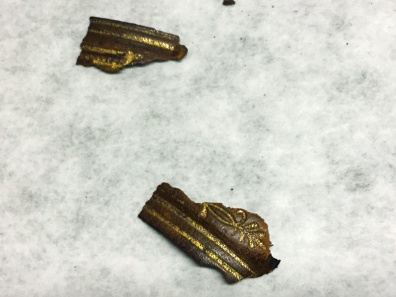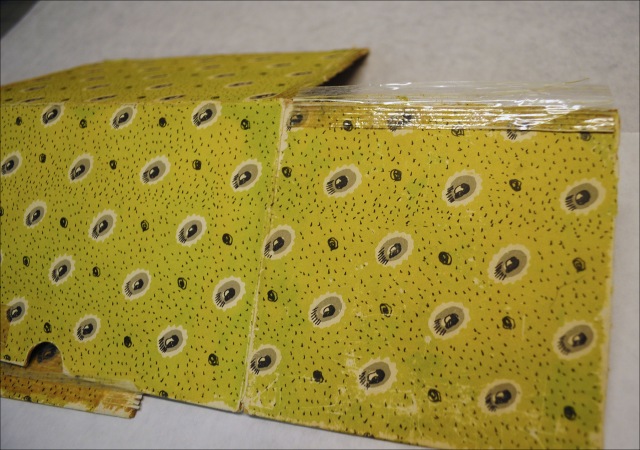I found the “before” pictures of Barnaby. Here they are.

Front Cover

Front cover, showing the remnants of late repair. Looking at this, I assume this repair leather was inserted underneath the original spine. It worked for a while, and then the rest of the original spine was lost.

Back of book, showing repair attached. Notice how the repair leather is pasted on TOP of the original boards, and only goes part way down. That’s probably because at the time that repair was made, part of the original spine was still attached. And normally the repair leather would have been put UNDER the cover leather, not on top of it.

Close up of the repair. If you look closely, you can see a piece of gold-tooled leather on top of the plain leather. I think this is a remnant of the original spine.

You can see how the repairer turned the leather in at the top. Part of the leather is dark – was the old label pasted on here?

The bookseller’s ticket is stuck inside the lower front inside cover. Myers & Co, 59 High Holborn, London, can’t make out the rest from the photo

Inside front of book.

Inside back of book. Sorry, it’s upside down.

Lovely gold tooling on the inside leather turn-ins, done with gold leaf using a decorated roll tool.

Corner shows some wear and loss of leather. Looks as if the finisher didn’t miter the corners, but just ran the roll off the end.

Inside back of book. See the plain leather folded over the decorated leather? That’s the repair leather, and it should have been tucked under the old leather, not glued on top of it.

Here the repair is being lifted off the spine. I did not dare use any water to soften the adhesive, because I feared it would blacken the old leather, so I lifted it with a scalpel. You can see that the top layer of the old leather was pulled off in the process.

A zoomed-out photo of the process. Old leather is being slowly lifted off mechanically.

Interesting. As the old leather comes off, I can see what looks like some of the original spine – the leather piece on the false raised band is probably from the original spine, along with the cardboard underneath it.

Here I am lifting the turned-on repair leather from the original leather. The old gold tooling, which was covered up, is starting to re-emerge.

The book is now pared down to the original parts. The repair has been removed, and you can see the change in color of the spine, and the lighter leather on the cover where the top layer of calf was stripped off. Now I can begin the restoration.






















































